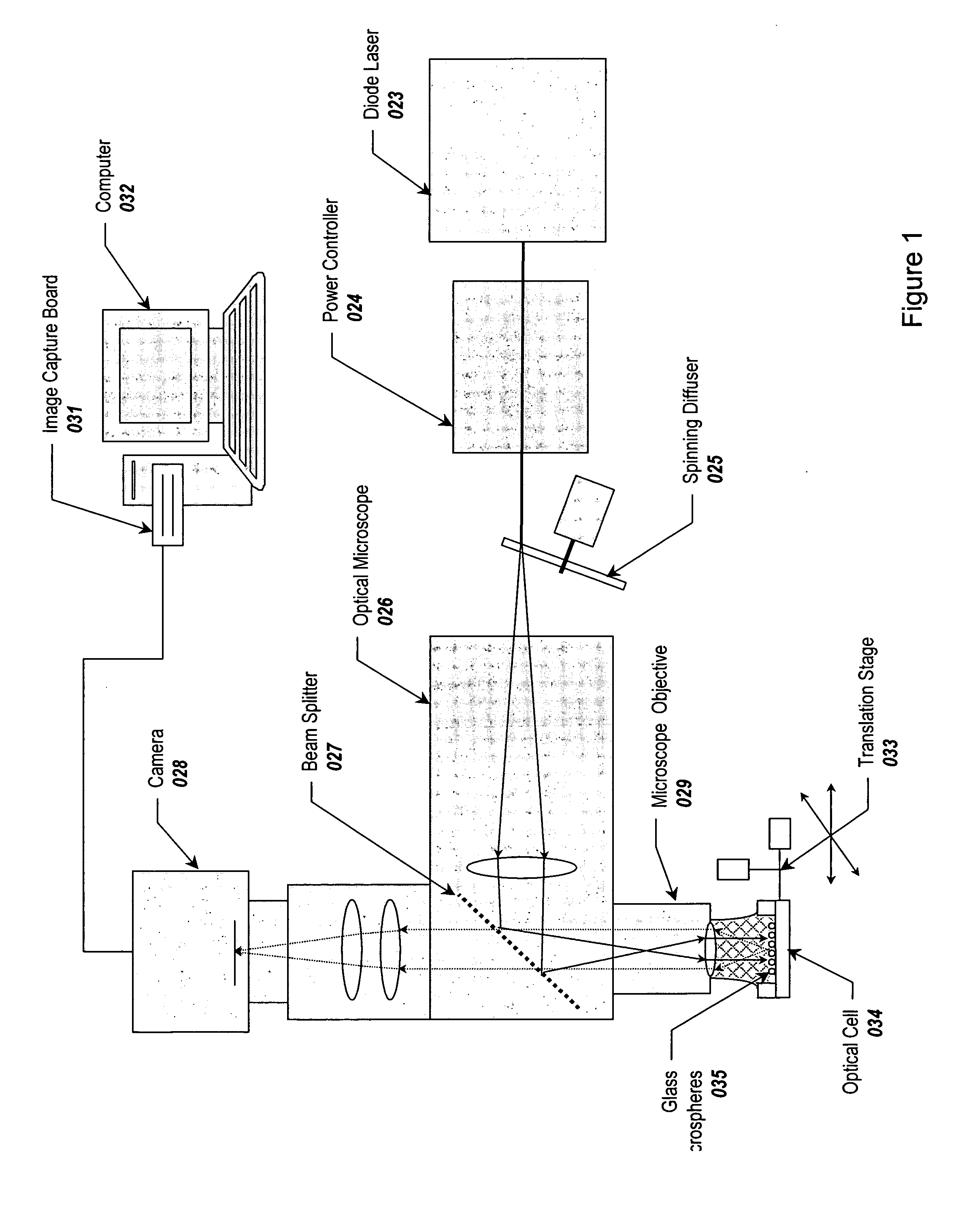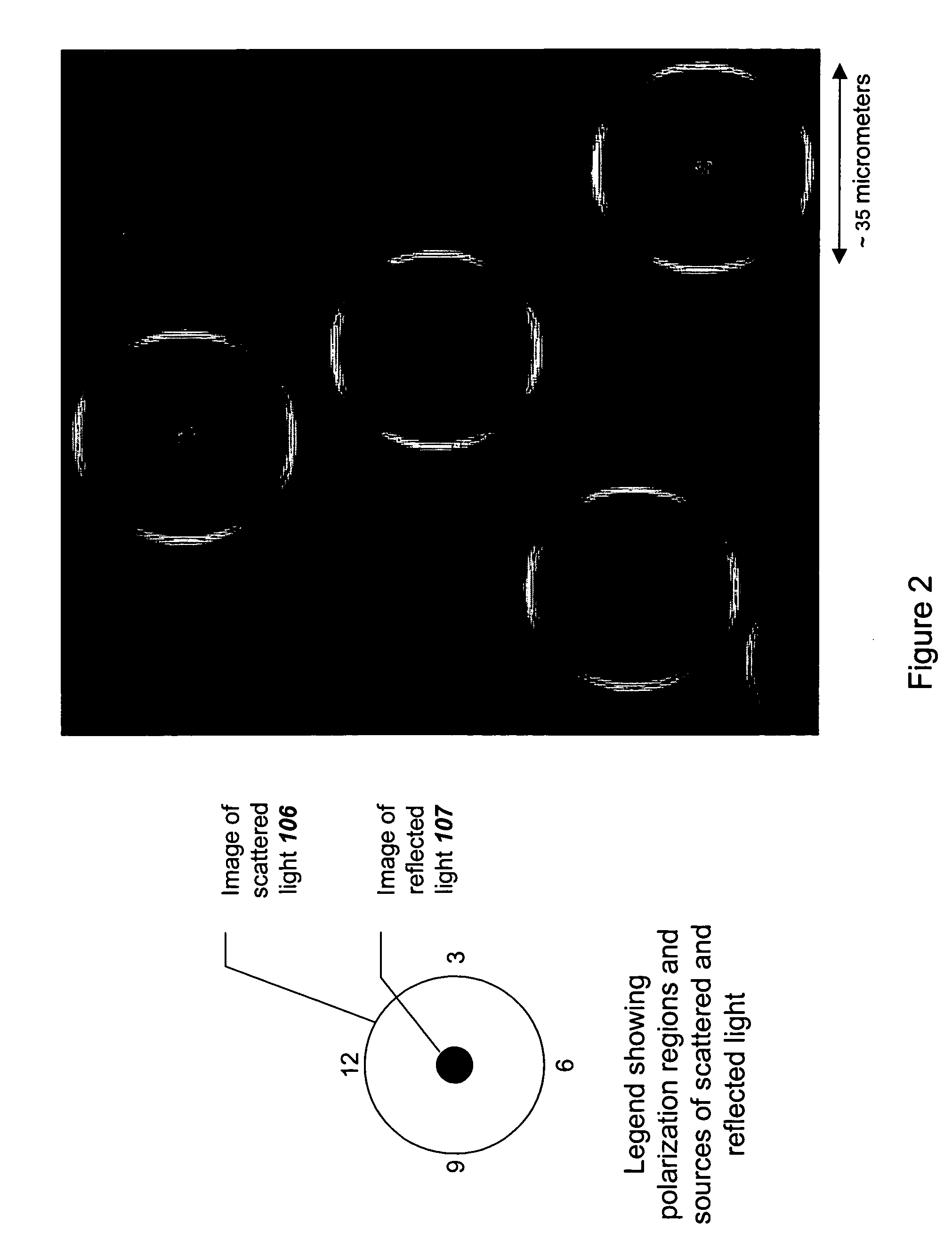Sol-gel coated glass microspheres for use in bioassay
a glass microsphere and glass coating technology, applied in the field of glass microspheres for bioassays, can solve the problems of limited method sensitivity, limited dynamic range, and no disclosure of particle having enhanced binding for bio-analytes or compositions needed for detection by resonant light scattering
- Summary
- Abstract
- Description
- Claims
- Application Information
AI Technical Summary
Problems solved by technology
Method used
Image
Examples
example 1
Microspheres Having an Aluminum Oxide Sol-Gel Coating on a Barium-Titanium-Silicon Oxide Glass Core with an Attached Biotin Probe
[0074] The purpose of this Example was to prepare barium-titanium-silicon oxide microspheres having an aluminum oxide sol-gel coating and an attached biotin probe.
Preparation of Aluminum Oxide Sol-Gel Coated Glass Microspheres:
[0075] Microspheres having the composition expressed by the following formula:
[Ba1−xTiySiy′By″Cay′″O(1−x+2y+2y′+3 / 2y″+y′″)]1−a(AOz)a;
wherein x=y+y′+y″+y′″; y=0.394; y′=0.1 13; y″=0.134; y′″=0.066; a=0.005; 2≧z≧0.5; and wherein A is a combination of Fe, Sr, Na, and Zr, were obtained from MO-SCI Specialty Products, LLC. (a subsidiary of MO-SCI Corporation, Rolla, Mo.). The microspheres were sieved between minus 40 and plus 10 μm screens by the supplier.
[0076] The microspheres (100 g) were pre-wetted with approximately 3 g of water, and added to a 3-L round-bottom flask equipped with an addition funnel. The round-bottom flask asse...
examples 2 and 3
Resonant Light Scattering Measurements of Streptavidin Binding to Biotinylated Microspheres
[0080] The purpose of these Examples was to demonstrate the increased wavelength shift in the resonant light scattering spectrum that was obtained upon binding of streptavidin to the biotinylated, aluminum oxide sol-gel coated microspheres described in Example 1 compared to that obtained with uncoated, biotinylated microspheres.
[0081] The resonant light scattering of the biotinylated, aluminum oxide sol-gel coated microspheres, described in Example 1, was measured using the method and instrumentation described below. For comparison, the measurements were also made using biotinylated microspheres that did not have the sol-gel coating. These biotinylated microspheres were prepared as described in Example 1, except that the sol-gel coating of aluminum oxide was not applied to the microspheres.
[0082] Five milliliters of PBS buffer (Sigma-Aldrich, St. Louis, Mo., Cat # 3813,) was flushed through...
example 4
Microspheres Having a Heat-Treated Aluminum Oxide Sol-Gel Coating on a Barium-Titanium-Silicon Oxide Glass Core with an Attached Biotin Probe
[0087] The purpose of this Example was to prepare barium-titanium-silicon oxide microspheres with a heat-treated aluminum oxide sol-gel coating and an attached biotin probe.
Preparation of Heat-Treated Aluminum Oxide Sol-Gel Coated Glass Microspheres:
[0088] The glass microspheres used were the same as described in Example 1. The procedure used to form the aluminum oxide sol-gel coating on the microspheres was similar to that described in Example 1, except that 30 g of the microspheres were used and the amounts of the reagents were scaled accordingly. The microspheres were pre-wetted with 4.5 mL of water. The microspheres were then treated with a 0.15 M solution of aluminum trisec-butoxide, as described in Example 1.
[0089] Approximately 11 g of the aluminum oxide sol-gel coated microspheres were calcined in a vertical fluidized bed. The flui...
PUM
| Property | Measurement | Unit |
|---|---|---|
| thickness | aaaaa | aaaaa |
| thickness | aaaaa | aaaaa |
| diameter | aaaaa | aaaaa |
Abstract
Description
Claims
Application Information
 Login to View More
Login to View More - R&D
- Intellectual Property
- Life Sciences
- Materials
- Tech Scout
- Unparalleled Data Quality
- Higher Quality Content
- 60% Fewer Hallucinations
Browse by: Latest US Patents, China's latest patents, Technical Efficacy Thesaurus, Application Domain, Technology Topic, Popular Technical Reports.
© 2025 PatSnap. All rights reserved.Legal|Privacy policy|Modern Slavery Act Transparency Statement|Sitemap|About US| Contact US: help@patsnap.com


